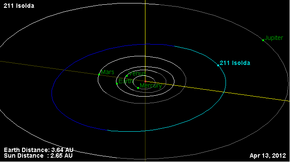211 Isolda is a very large, dark main-belt asteroid. It is classified as a C-type asteroid and is probably composed of primitive carbonaceous material. The spectra of the asteroid displays evidence of aqueous alteration.[6]
 Orbital diagram | |
| Discovery | |
|---|---|
| Discovered by | Johann Palisa |
| Discovery date | 10 December 1879 |
| Designations | |
| (211) Isolda | |
| Pronunciation | /ɪˈzoʊldə/[1] |
Named after | Iseult |
| A879 XA, 1912 AB 1912 BA, 1950 FM | |
| Main belt | |
| Adjectives | Isoldian /ɪˈzoʊldiən/[2] |
| Orbital characteristics[3] | |
| Epoch 31 July 2016 (JD 2457600.5) | |
| Uncertainty parameter 0 | |
| Observation arc | 136.19 yr (49742 d) |
| Aphelion | 3.53270 AU (528.484 Gm) |
| Perihelion | 2.5514 AU (381.68 Gm) |
| 3.04205 AU (455.084 Gm) | |
| Eccentricity | 0.16129 |
| 5.31 yr (1938.0 d) | |
Average orbital speed | 17.08 km/s |
| 260.142° | |
| 0° 11m 8.74s / day | |
| Inclination | 3.8856° |
| 263.644° | |
| 173.522° | |
| Physical characteristics | |
| Dimensions | 143.19±5.1 km[3] 149.81 ± 6.10 km[4] |
| Mass | (4.49 ± 2.43) × 1018 kg[4] |
Mean density | 2.54 ± 1.41 g/cm3[4] |
| 18.365 h (0.7652 d) | |
| 0.0602±0.004[3] 0.0598 ± 0.0218[5] | |
| C[5] (Tholen) | |
| 7.89,[3] 7.90[5] | |
It was discovered by Austrian astronomer Johann Palisa on 10 December 1879, in Pola, and is possibly named after Isolde, heroine of the legend of Tristan and Iseult.[7]
In 2001, the asteroid was detected by radar from the Arecibo Observatory at a distance of 1.78 AU. The resulting data yielded an effective diameter of 143 ± 16 km.[8]
Between 2009 and 2022, 211 Isolda has been observed to occult seven stars.[citation needed]
References
edit- ^ "Isolde". Lexico UK English Dictionary. Oxford University Press. Archived from the original on 1 March 2020.
- ^ Irene Masing-Delic (1992) Abolishing Death: A Salvation Myth of Russian Twentieth-Century Literature, p. 163
- ^ a b c d "211 Isolda". JPL Small-Body Database. NASA/Jet Propulsion Laboratory. Retrieved 12 May 2016.
- ^ a b c Carry, B. (December 2012), "Density of asteroids", Planetary and Space Science, 73 (1): 98–118, arXiv:1203.4336, Bibcode:2012P&SS...73...98C, doi:10.1016/j.pss.2012.03.009. See Table 1.
- ^ a b c Pravec, P.; et al. (May 2012), "Absolute Magnitudes of Asteroids and a Revision of Asteroid Albedo Estimates from WISE Thermal Observations", Asteroids, Comets, Meteors 2012, Proceedings of the conference held May 16–20, 2012 in Niigata, Japan, vol. 1667, no. 1667, p. 6089, Bibcode:2012LPICo1667.6089P. See Table 4.
- ^ Fornasier, S.; et al. (February 1999), "Spectroscopic comparison of aqueous altered asteroids with CM2 carbonaceous chondrite meteorites", Astronomy and Astrophysics Supplement, 135: 65−73, Bibcode:1999A&AS..135...65F, doi:10.1051/aas:1999161.
- ^ Schmadel, L. (2003:31). Dictionary of minor planet names. Germany: Springer.
- ^ Magri, Christopher; et al. (January 2007), "A radar survey of main-belt asteroids: Arecibo observations of 55 objects during 1999 2003" (PDF), Icarus, 186 (1): 126–151, Bibcode:2007Icar..186..126M, doi:10.1016/j.icarus.2006.08.018, retrieved 14 April 2015.
External links
edit- The Asteroid Orbital Elements Database
- Minor Planet Discovery Circumstances
- Asteroid Lightcurve Data File
- 211 Isolda at AstDyS-2, Asteroids—Dynamic Site
- 211 Isolda at the JPL Small-Body Database